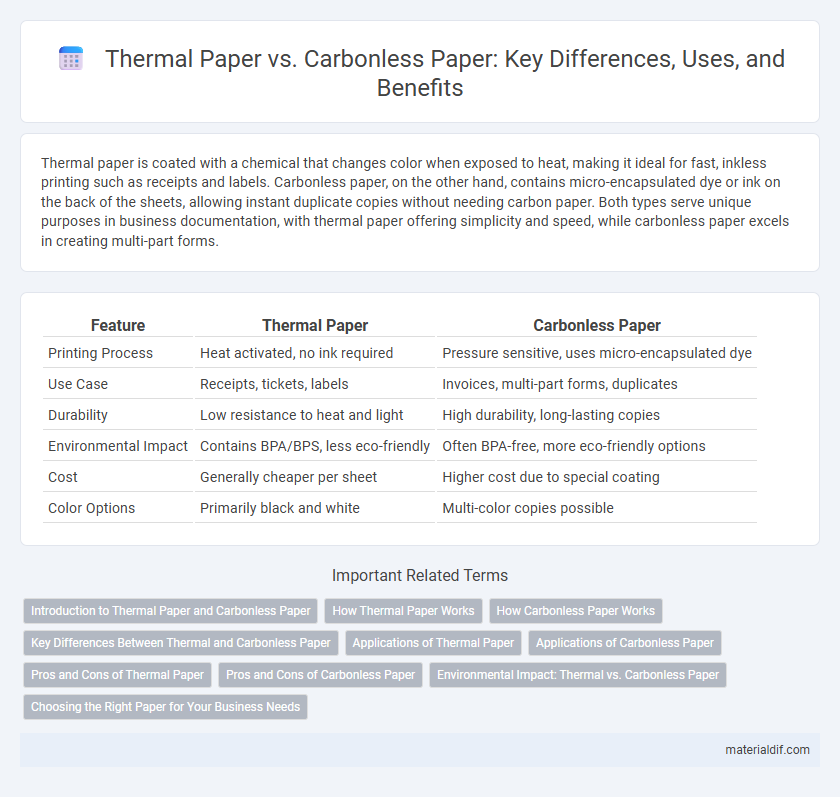Thermal paper is coated with a chemical that changes color when exposed to heat, making it ideal for fast, inkless printing such as receipts and labels. Carbonless paper, on the other hand, contains micro-encapsulated dye or ink on the back of the sheets, allowing instant duplicate copies without needing carbon paper. Both types serve unique purposes in business documentation, with thermal paper offering simplicity and speed, while carbonless paper excels in creating multi-part forms.
Table of Comparison
| Feature | Thermal Paper | Carbonless Paper |
|---|---|---|
| Printing Process | Heat activated, no ink required | Pressure sensitive, uses micro-encapsulated dye |
| Use Case | Receipts, tickets, labels | Invoices, multi-part forms, duplicates |
| Durability | Low resistance to heat and light | High durability, long-lasting copies |
| Environmental Impact | Contains BPA/BPS, less eco-friendly | Often BPA-free, more eco-friendly options |
| Cost | Generally cheaper per sheet | Higher cost due to special coating |
| Color Options | Primarily black and white | Multi-color copies possible |
Introduction to Thermal Paper and Carbonless Paper
Thermal paper is a specialized type of paper coated with a chemical that changes color when exposed to heat, commonly used in receipt printers and fax machines due to its fast and quiet printing process. Carbonless paper, also known as NCR (No Carbon Required) paper, contains micro-encapsulated dye or ink that transfers to the subsequent sheets when pressure is applied, eliminating the need for carbon sheets in multi-part forms. Both paper types enhance efficiency and convenience in printing applications but differ significantly in technology and usage scenarios.
How Thermal Paper Works
Thermal paper works by using heat-sensitive chemicals embedded in the paper's coating that change color when exposed to a thermal printhead. This process eliminates the need for ink, toner, or ribbons, producing crisp, high-resolution images instantly. In contrast to carbonless paper, which relies on micro-encapsulated dye, thermal paper's reactive coating enables faster and quieter printing ideal for receipts and labels.
How Carbonless Paper Works
Carbonless paper works by using micro-encapsulated dye or ink on the back of the top sheet, which breaks upon pressure and reacts with a clay coating on the sheet below to create a copy without the need for carbon paper. This chemical reaction forms a durable, clear copy immediately as the pressure transfers the dye to the receiving sheet. Unlike thermal paper, carbonless paper produces multiple copies instantly without requiring heat or special printers.
Key Differences Between Thermal and Carbonless Paper
Thermal paper relies on heat-sensitive coating that changes color when exposed to heat, while carbonless paper uses micro-encapsulated dye that reacts upon pressure to transfer images without carbon sheets. Thermal paper produces sharp, high-contrast prints instantly but may fade over time, whereas carbonless paper offers durable, multi-part copies ideal for forms and receipts requiring duplicates. The choice depends on application needs: thermal paper suits quick, single-copy receipts, while carbonless paper is preferred for multi-copy documentation.
Applications of Thermal Paper
Thermal paper is widely used in receipt printing, label production, and ticketing due to its heat-sensitive coating that produces images without ink. Its applications span retail, banking, healthcare, and logistics, providing fast, reliable, and cost-effective printing solutions. Thermal paper's resistance to smudging and environmental factors makes it ideal for point-of-sale systems and shipping labels.
Applications of Carbonless Paper
Carbonless paper is widely utilized in business forms such as invoices, receipts, and multi-part order forms due to its ability to create instant duplicates without the need for carbon sheets. It is essential in industries like retail, banking, and healthcare where accurate and efficient record-keeping is critical. The ease of handling and eliminating cleanup make carbonless paper ideal for high-volume, real-time documentation processes.
Pros and Cons of Thermal Paper
Thermal paper offers fast printing speeds and high-resolution images, making it ideal for receipts and labels, but it is sensitive to heat and light, which can cause fading over time. Its chemical coating enables direct printing without ink, reducing maintenance costs but posing environmental concerns due to its non-recyclable nature. While thermal paper significantly lowers printer noise and mechanical complexity, it can be more expensive than standard paper and is less durable under harsh conditions.
Pros and Cons of Carbonless Paper
Carbonless paper eliminates the need for messy carbon sheets, offering a cleaner and more efficient solution for multi-part forms. It provides excellent image quality and fast transfer times but can be sensitive to heat, moisture, and light, which may cause fading or discoloration over time. While carbonless paper supports environmental sustainability by reducing waste, it generally incurs higher upfront costs and has limited archival durability compared to thermal paper.
Environmental Impact: Thermal vs. Carbonless Paper
Thermal paper generates significant environmental concerns due to BPA and BPS chemicals used in its coating, which pose pollution and health risks during production and disposal. Carbonless paper, while avoiding chemical coatings, often contains microcapsules with dyes and solvents that can contribute to waste toxicity if not properly managed. Both paper types impact forests, but carbonless paper typically undergoes less processing, offering a potentially lower carbon footprint when sourced sustainably.
Choosing the Right Paper for Your Business Needs
Thermal paper offers fast, high-quality printing without ink, ideal for receipts and labels requiring durability and resistance to smudging. Carbonless paper eliminates the need for carbon sheets, enabling multi-part forms that transfer writing through pressure, perfect for invoices and order forms. Selecting the right paper depends on factors like print permanence, environmental conditions, and the type of transaction documentation your business requires.
Thermal paper vs Carbonless paper Infographic

 materialdif.com
materialdif.com